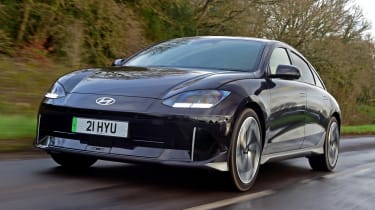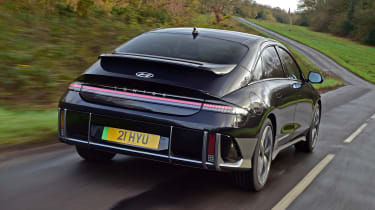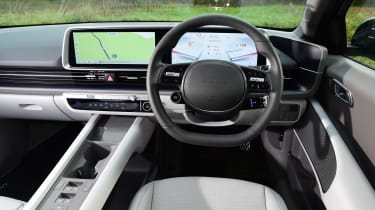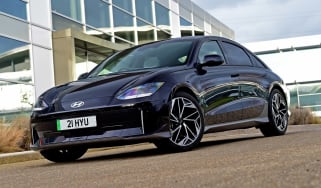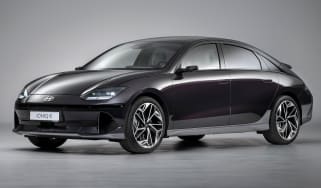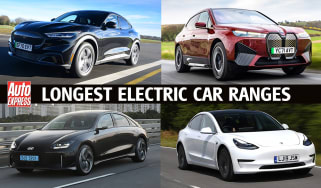New Hyundai Ioniq 6 2023 review
The new Hyundai Ioniq 6 EV follows on from the Ioniq 5 and is an even more impressive offering
Verdict
The Ioniq 6 isn’t without the odd foible, but it does manage to feel another step on from the already-impressive 5. The bodystyle and packaging mean it won’t be for everyone, but it’s a more inspiring package dynamically, building on many of the strengths of the Ioniq 5. That should be enough for it to be one of 2023’s hottest EVs.
Hyundai’s Ioniq 5 is one of the defining cars of the past few years – a vehicle with bold design and tech that marked the Korean brand’s emergence as a real superpower, particularly in the electric-car era. Now the company is aiming to build on that success with the Ioniq 6, a swoopy new saloon that’ll start arriving in dealers by the summer. And we’ve been able to try an early production example on UK roads.
The nomenclature might lead you to expect the 6 to be positioned a notch above the 5, but that isn’t quite the case. There is a premium, but it’s a modest one; the new model’s line-up starts with a 225bhp rear-wheel-drive edition at £46,745, just £600-odd up on the comparable 5.
The new arrival is a remarkably different-looking creation than the five-door, and while you are more likely to notice some similarities between the two cars on the road, there are significant differences as well. Everything in the drivetrain seems to have been tightened up a notch, so while the Ioniq 5 was never whiny or jerky, the 6 achieves another level of refinement. The fact that our test example was rear-wheel drive probably helps here, but it’s hard to detect much electric motor noise at all.
The modulation of the control weights is smoother than before, too; the 225bhp edition driven here doesn’t quite have Tesla-esque EV punch but even so, the Ioniq 6 manages to deliver instant torque with impressive progression. The calibration of the brake pedal is equally impressive, because that tricky transition between energy recuperation and actual discs and pads is nicely judged. Again, you can feel Ioniq evolution here.
There’s more of a jump than a gentle shift in chassis dynamics, even though the 6 shares the same E-GMP underpinnings as the 5. The new arrival is more than 20cm longer overall, with longer overhangs, yet its roofline sits a full 11cm lower. This drop in the centre of gravity is harnessed by what feels like a firmer suspension set-up to deliver improved body control and quicker reactions to steering inputs. You can point the 6 at a corner with confidence, assured that it’ll resist wallowing off line.
The trade-off for this is a ride that never quite settles; the Ioniq 5 is unashamedly soft, and has always had a tendency to float and waft, often taking a second attempt to settle over longer undulations. The 6 is undoubtedly better tied down, but you’re more likely to feel patter from beneath as lesser road imperfections are picked up through the chassis. It’s never genuinely uncomfortable, though – even on the 20-inch wheels fitted to the car we drove – so we’d say it’s a price worth paying for a more complete dynamic package.
The more slippery shape gives the 6 a longer range than its stablemate; its 74kWh (usable) battery is enough for 338 miles on a single charge. Again, the Hyundai’s figures are a rough match for those of the rear-drive Tesla Model 3, although that car is cheaper.
Inside, the materials feel just a little more premium than the 5’s throughout, and there’s less evidence of harsher, more easily scratched plastics.
There are compromises on space, though. While there’s oodles of legroom for five adults, anyone measuring six feet tall or more may well struggle for headroom in the 6 – not only in the rear, where they’re likely to find their head squished against the roof liner, but even behind the wheel. Adopt an upright driving position and you may well find the top of your head disappearing into the sunroof cutout.
The boot, too, is long, wide and shallow, and the aperture to load items through is an odd shape, so the load bay probably isn’t quite as practical as the decent enough capacity of 401 litres would suggest. At least the rear-drive editions get a 45-litre ‘wetbox’ trunk beneath the bonnet – handy for stowing the charging cables.
| Model: | Hyundai Ioniq 6 Ultimate RWD |
| Price: | £50,245 |
| Engine/battery: | 1x e-motor, 74kWh (usable) |
| Power/torque: | 225bhp/350Nm |
| Transmission: | Single-speed automatic, rear-wheel drive |
| 0-62mph: | 7.4 seconds |
| Top speed: | 7.4 seconds/115mph |
| Range: | 338 miles |
| Charging: | 220kW (10-80% 18mins) |
| On sale: | Now |

